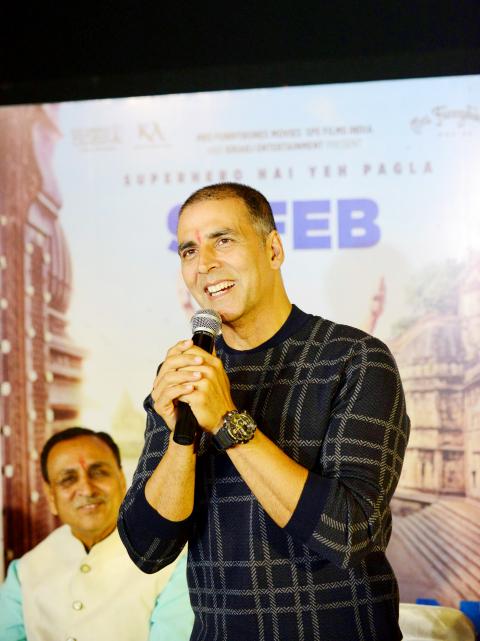A Bollywood movie about an inventor who created a revolutionary machine that makes cheap sanitary pads hits screens this week, challenging taboos surrounding menstruation in socially conservative India.
Arunachalam Muruganantham is nicknamed India’s “menstrual man” for transforming the lives of poor women forced to use items like old rags, sand and leaves during their periods.
He has been lauded by India’s government and is now getting the star treatment with Bollywood A-lister Akshay Kumar portraying him in Pad Man, releasing on Friday.

Photo: AFP
It is the latest socially conscious movie to come out of a film industry known more for producing complex love stories featuring handsome heroes and elaborate dance routines.
Muruganantham hopes the movie will help raise awareness about the importance of menstrual hygiene in patriarchal India where women, particularly in rural areas, are frequently shunned during their monthly cycles.
“Menstruation is still a taboo subject in India and a tough subject for a film,” he told AFP by phone from his home state of Tamil Nadu in southern India.
“But I read the script and I was also on the sets to guide them. I think [R] Balki [the writer and director] has handled the subject beautifully. People will talk about personal hygiene and it will give hope to the younger generation to do innovative things,” he added.
Muruganantham’s remarkable story began in the late 1990s when he was shocked to discover that his wife was using newspaper and dirty cloths during menstruation because sanitary pads were too expensive. He decided to do something about it and started experimenting with different designs using cotton. His first few prototypes were not very successful and quickly his wife and sisters refused to be guinea pigs any longer. When other women in the village balked at his requests to try his products he started testing them on himself, using a football bladder and animal blood.
Muruganantham was mocked and ostracized by fellow villagers, and his wife even left him for a while, but he remained undeterred and intensified his search. After two years he discovered that sanitary pads are made from cellulose found on trees.
RISKY
Muruganantham also learned that the machine which ground down the pulp before turning it into napkins cost hundreds of thousands of dollars so he decided to create his own.
In four years he had invented an easy-to-use device which could produce pads at a third of the cost of the commercially produced ones. The machines themselves were also vastly cheaper at around 75,000 rupees (US$1,170).
“I wanted to make sure that technically we did not go wrong, so he agreed to supervise,” Balki, the director, said of Muruganantham’s role on set.
Actresses Radhika Apte and Sonam Kapoor star alongside Kumar whose character, based on Muruganantham, is called Lakshmi.
The 50-year-old actor, whose films regularly rake in more than one billion rupees (US$15.6 million) at the box office, is no stranger to starring in movies with an important message.
Last year’s comedy, Toilet: Ek Prem Katha (Toilet: A love story), focused on the lack of toilets in India and the problem of open defecation. It was a massive hit, grossing upwards of US$2 billion rupees, but Balki says a film about periods is an altogether different proposition.
“Pad Man is possibly the riskiest film Akshay has done because of the taboo, unexplored subject,” he told AFP.
Several million more Indian women are now estimated to use sanitary pads thanks to Muruganantham. His company, Jayaashree Industries, has more than 2,000 units across the majority of India’s states and also exports to dozens of countries. The machines also provide employment to thousands of rural women.
In 2014 he was included in Time magazine’s list of 100 most influential people in the world. Two years later India’s government awarded Muruganantham one of the country’s highest civilian honors.
The release of Pad Man is set to elevate his fame further but he insists he won’t be letting it go to his head.
“The cause is becoming big, but I am remaining the same,” he said.

In the next few months tough decisions will need to be made by the Taiwan People’s Party (TPP) and their pan-blue allies in the Chinese Nationalist Party (KMT). It will reveal just how real their alliance is with actual power at stake. Party founder Ko Wen-je (柯文哲) faced these tough questions, which we explored in part one of this series, “Ko Wen-je, the KMT’s prickly ally,” (Aug. 16, page 12). Ko was open to cooperation, but on his terms. He openly fretted about being “swallowed up” by the KMT, and was keenly aware of the experience of the People’s First Party

Aug. 25 to Aug. 31 Although Mr. Lin (林) had been married to his Japanese wife for a decade, their union was never legally recognized — and even their daughter was officially deemed illegitimate. During the first half of Japanese rule in Taiwan, only marriages between Japanese men and Taiwanese women were valid, unless the Taiwanese husband formally joined a Japanese household. In 1920, Lin took his frustrations directly to the Ministry of Home Affairs: “Since Japan took possession of Taiwan, we have obeyed the government’s directives and committed ourselves to breaking old Qing-era customs. Yet ... our marriages remain unrecognized,

During the Metal Ages, prior to the arrival of the Dutch and Chinese, a great shift took place in indigenous material culture. Glass and agate beads, introduced after 400BC, completely replaced Taiwanese nephrite (jade) as the ornamental materials of choice, anthropologist Liu Jiun-Yu (劉俊昱) of the University of Washington wrote in a 2023 article. He added of the island’s modern indigenous peoples: “They are the descendants of prehistoric Formosans but have no nephrite-using cultures.” Moderns squint at that dynamic era of trade and cultural change through the mutually supporting lenses of later settler-colonialism and imperial power, which treated the indigenous as

Standing on top of a small mountain, Kim Seung-ho gazes out over an expanse of paddy fields glowing in their autumn gold, the ripening grains swaying gently in the wind. In the distance, North Korea stretches beyond the horizon. “It’s so peaceful,” says the director of the DMZ Ecology Research Institute. “Over there, it used to be an artillery range, but since they stopped firing, the nature has become so beautiful.” The land before him is the demilitarized zone, or DMZ, a strip of land that runs across the Korean peninsula, dividing North and South Korea roughly along the 38th parallel north. This